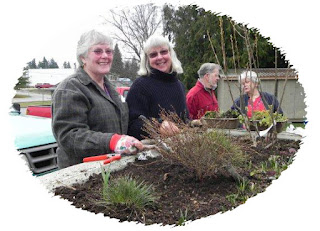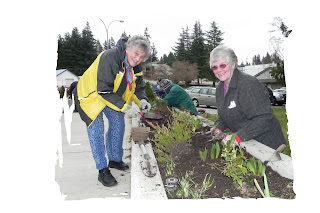Below is an excerpt from
"The Vegetable Gardener's Container Bible", written by Edward C. Smith. This informative book is a recent addition to the gardening section of our wonderful
Powell River Library.
Why Do Plants Need Water?
Although most people realize that plants need water, not all of them are clear about why. Until you understand this, you won't be clear about how much water plants need, how often they need it, and which kind of container will keep plants as hydrated as they need to be.
Plants Are Mostly Water
Like other living things, plants are made up almost totally of water, at least 80 to 90 percent. Water provides the firmness we observe in healthy plant tissue. Conversely, the sign that a plant has too little water is wilting: drooping leaves and stems. Plants that are starved for water produce fewer, smaller, and less juicy and tasty fruits.
Plants Need Water For Photosynthesis
Hydrogen, one of the basic plant nutrients, comes from the H in H2O. During photosynthesis, photons (energy from the sun) break apart water molecules, freeing hydrogen atoms. The hydrogen then combines with carbon (from carbon dioxide in the air) to form carbohydrates - the building blocks of plant tissue.
Plant Nutrients Pass Through Water
There must be a film of water around each root hair in order for nutrients to pass from the soil to the plant. Whenever there is not enough water around the roots of a plant, nutrients fail to move into the plant, and growth slows. If the soil dries even more, root hairs dry out and die. At this point, the plant is severely stressed and growth is interrupted. Even if the plant survives the ordeal, the quality, size, and taste of the harvest have been compromised, and that plant is not likely to become the plant it could have been.
All Creatures Living In Soil Need Water
In my experience, plants grow best in a soil that is alive, literally, teeming with mostly microscopic creatures that supply plants with food, creatures that help them to assimilate food, creatures that help protect plants from predation and disease. Those soil-dwelling creatures all need water. In the absence of water, they go dormant or die.
Plants Need Water For Transpiration
All of those reasons put together amount to only two percent of the water a plant needs. The other 98 percent of the water a plant needs passes through the plant and exits through its leaves by a process called transpiration. What a waste! Except, of course, that nature doesn't really waste anything; the water used in transpiration is essential to the normal growth and health of the plant.
Water leaving a plant through transpiration doesn't just leave; it creates by its leaving a force called transpirational pull, which both draws more water into the plant through its roots and provides for water movement within plant tissues. Plants don't have a heart the way humans and other animals do. Transpiration is the plant's substitute for a heart; it is the way a plant moves fluids within itself. Without transpiration, plants could not move water and nutrients rom the soil, could not make sugars through the miracle of photosynthesis, could not move those sugars about and change them into starches - could not, in short, grow, mature, fruit, and produce seeds.
Transpiration serves another important function - it dissipates heat from the sun (much like perspiration does in an animal). That cooling is critical to a plant's survival.
As examples, Mr. Smith states "growing in fertile soil, a tomato plant can grow more than 7 feet tall and sport a diameter of 3 feet or more...and suck up as much as 1 gallon (3.78541178 litres for us Canadians) of water every day. A summer squash needs at least a gallon a day. Big plants with lots of leaf surface area, like broccoli, need lots and lots of water."
The information found in this well organized, informative, wonderfully illustrated book by Edward C. Smith would be valuable to every gardener - particularly for the novice contemplating growing their own food in a limited area (containers). Mr. Smith's other book,
"The Vegetable Gardener's Bible", is also available at the Powell River Library.















